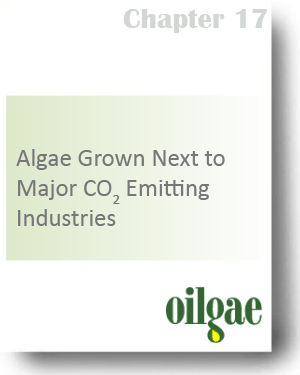Chapter XVII - Algae Grown Next to Major CO2 Emitting Industries
This page provides details of the chapter XVII, from the Comprehensive Oilgae Report. You can purchase this chapter alone using the payment button provided below.
Introduction
CO2 sequestration refers to the process of isolating and storing CO2 which is a greenhouse gas. The conventional CO2 sequestration processes are highly power intensive and as a result, expensive. In a country like the U.S., where coal is the major fuel for power production, costs involved in sequestering CO2 emissions will run into several billions.
Many scientists and environmentalists think that algal farming, when it aligned closely to nature, will give the most promising results in this context. This chapter deals with the algae- based CO2 abatement with its various challenges and the current research works in this area of study.
List of Contents
- Introduction & Concepts
- Algal Species Suited for CO2 Capture of Power Plant Emissions
- Methods & Processes
- Case Studies
- Challenges while Using Algae for CO2 Capture
- Research and Data for Algae-based CO2 Capture
- Algae-based CO2 Capture - Factoids
- Algae Cultivation Coupled with CO2 from Power Plants – Q&A
- Prominent CO2 Emitting Industries
- Status of Current CO2 Capture and Storage (CCS) Technologies
- Latest Developments in CO2 Sequestration
- Reference
List of Tables
- Example of a Typical Flue Gas Composition from Coal Fired Power Plant
- Summary of Availability and Cost of CO2 Sources
- Projected Global Energy Demand and CO2 Emissions, 2000 to 2020
- CO2 Tolerance of Various Species
- Energy and GHG (CO2) Balance per Liter of Oil Produced Using Three Different Technologies.
- Estimated Costs for CO2 Sequestration Using Algae Grown for Six Months per Year in BC
- Algae Project Data
- Select List of Research on Microalgae Fixation as a Process for Post-combustion CO2 Capture
- Composition of Gas Mixtures
- Solubilities of Flue Gas Components
- Data Related to Algae-Based CO2 Capture
- Countries Heavily Dependent on Coal for Electricity (2006e)
- Top Coal Importers (2006e)
List of Figures
- Picture of CO2 Sequestration of Coal Plant Emissions
- Flow Diagram for Microalgae Production with Introduction of CO2 from Fossil Fuel Fired Power Plants.
- Flow diagram for Microalgae Production
- Schematic diagram of the flue-gas link-up
- Gas analysis of coal combustion gases before and after passage through photobioreactor
- Concentration of CO2 in the gas stream supplied from the propane combustor into the photobioreactor and in the gas stream leaving the photobioreactor
- Coal in Electricity Generation
Key Takeaways from the chapter
- For power plants and other entities that are large scale emitters of CO2, sequestering CO2 using algae provides the opportunity of monetizing through carbon credits while at the same time producing biofuels.
- It is expected that in future, commercial profit from algae biomass production could offset overall operational costs for CO2 sequestration.
- In addition to CO2 sequestration, another potential strategy to offset operational costs is to develop multi-functional systems such as waste treatment in conjunction with algae cultivation at power plants.
- Some research programs suggest that CO2 recovery for algae growth from existing processes at ethanol and ammonia plants could be relatively lower in cost than from cement, refineries, or power plants
- Over a dozen companies worldwide have made significant investments into algae-based CO2 capture research.
- Key challenges involve the large land requirements, inefficiencies in the actual process of CO2 capture and high costs of cultivation if photobioreactors are used.
- While algae-based CO2 abatement inherently has excellent potential, it is not expected to become commercialized until 2015.
We are no more selling this report. |
|
No of Pages : 56 Last Updated : Dec 2011 Price : 200 US $ |
Related Chapters from the Section III – Processes & Challenges

